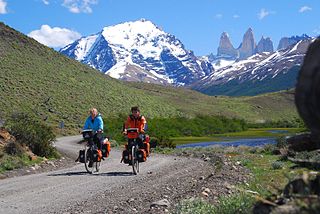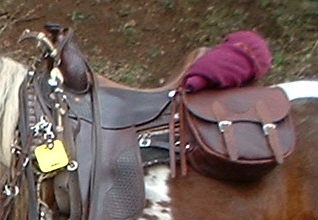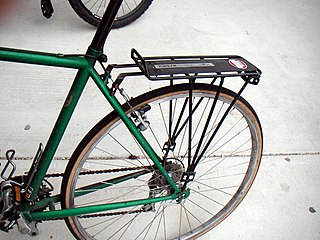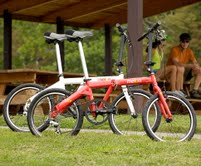
The penny-farthing, also known as a high wheel, high wheeler or ordinary, is an early type of bicycle. It was popular in the 1870s and 1880s, with its large front wheel providing high speeds, owing to it travelling a large distance for every rotation of the legs, and comfort, because the large wheel provided greater shock absorption.

Mountain biking is a sport of riding bicycles off-road, often over rough terrain, usually using specially designed mountain bikes. Mountain bikes share similarities with other bikes but incorporate features designed to enhance durability and performance in rough terrain, such as air or coil-sprung shocks used as suspension, larger and wider wheels and tires, stronger frame materials, and mechanically or hydraulically actuated disc brakes. Mountain biking can generally be broken down into distinct categories: cross country, trail, all mountain, enduro, downhill and freeride.

Bicycle touring is the taking of self-contained cycling trips for pleasure, adventure or autonomy rather than sport, commuting or exercise. Bicycle touring can range from single-day trips to extended travels spanning weeks or months. Tours may be planned by the participant or organized by a tourism business, local club or organization, or a charity as a fund-raising venture.

A touring bicycle is a bicycle designed or modified to handle bicycle touring. To make the bikes sufficiently robust, comfortable and capable of carrying heavy loads, special features may include a long wheelbase, frame materials that favor flexibility over rigidity, heavy duty wheels, and multiple mounting points.

A pannier is a basket, bag, box, or similar container, carried in pairs either slung over the back of a beast of burden, or attached to the sides of a bicycle or motorcycle. The term derives from a Middle English borrowing of the Old French panier, meaning 'bread basket'.

A racing bicycle, also known as a road bike is a bicycle designed for competitive road cycling, a sport governed by and according to the rules of the Union Cycliste Internationale (UCI).

The Birdy is a folding bicycle designed by Riese und Müller in Germany and produced by Pacific Cycles in Taiwan. As of 2010 over 100,000 had been sold. Three distinct models have been marketed, in addition to some specialist variations, with the third (Mk3) introduced in July 2015.

This is a glossary of terms and jargon used in cycling, mountain biking, and cycle sport.

Saddlebags are bags that are attached to saddles.

A bicycle basket is a bicycle-mounted basket for carrying cargo, usually light cargo. They are usually used for light shopping duties such as going on daily visits to the shops for fresh bread or milk. Baskets are often mounted on the handlebars and made of traditional basket weaving materials such as wicker and cane or even woven plastic that merely looks like wicker or cane. They can also be made of other materials such as metal mesh. Euroboxes or milk crates are also used as bicycle baskets.

Bikecentennial '76 was an event consisting of a series of bicycle tours on the TransAmerica Bicycle Trail across the United States in the summer of 1976 in commemoration of the bicentennial of America's Declaration of Independence. The route crossed ten states, 22 national forests, two national parks, and 112 counties between Astoria, Oregon, and Yorktown, Virginia, a distance of about 4,250 miles (6,840 km). The route was chosen to take cyclists through small towns on mostly rural, low-traffic roads.

A luggage carrier, also commonly called a (bicycle)rack, is a device attached to a bicycle to which cargo or panniers can be attached. This is popular with utility bicycles and touring bicycles.
Motorcycle accessories are features and accessories selected by a motorcycle owner to enhance safety, performance, or comfort, and may include anything from mobile electronics to sidecars and trailers. An accessory may be added at the factory by the original equipment manufacturer or purchased and installed by the owner post-sale as aftermarket goods. The term Farkle is used within the motorcycle community, originally to denote useful add-ons, such as GPS or other upgraded components. Now also used at times in a humorous or mildly derogatory way to describe bling, such as anodized or chromed parts that add no functionality.

Mixed terrain cycle touring is the practice of cycling over a variety of surfaces and topography on a single route, with a single bicycle. The recent popularity of mixed terrain touring is in part a reaction against the increasing specialization of the bike industry.

Melon Bicycles was a folding bicycle manufacturer based in Chapel Hill, North Carolina. Many cyclists refer to the company as Melon Bikes, Melon Bicycles, or simply Melon. Melon Bicycles went out of business in 2014.
The Tour Divide is an annual mountain biking ride traversing the length of the Rocky Mountains, from Canada to the Mexican border. Following the 2,745-mile (4,418 km) Great Divide Mountain Bike Route, it is an ultra-distance cycling ride that is an extreme test of endurance, self-reliance and mental toughness. The ride format is strictly self-supported, and it is not a stage race - the clock runs continuously from the start until riders cross the finish line, usually more than two weeks later.

A fatbike is an off-road bicycle built to accommodate oversized tyres, typically 3.8 in (97 mm) or larger and rims 2.16 in (55 mm) or wider, designed for low ground pressure to allow riding on soft, unstable terrain, such as snow, sand, bogs and mud. Fatbikes are built around frames with wide forks and stays to accommodate the space required to fit these wide rims and tires. The wide tires can be used with inflation pressures as low as 34 kPa; 0.34 bar (5 psi) to allow for a smooth ride over rough obstacles. A rating of 55–69 kPa; 0.55–0.69 bar (8–10 psi) is suitable for most riders. Fatbikes were developed for use in snow or sand, but are capable of traversing diverse terrain types including snow, sand, desert, bogs, mud, pavement, or traditional mountain biking trails.
The definition of ultra-distance cycling is far more vague than in ultra running or in ultra-triathlon. Any bike race or ride longer than a century ride, which is 100 miles (160 km), is sometimes considered to be ultra-distance cycling. However, such events are relatively common, so using a longer distance to define the category is more useful, such as any race or ride that is longer than 200 kilometres (120 mi), 300 kilometres (190 mi) or even a double century, 200 miles (320 km).
Lael Wilcox is an ultra-endurance bicycle racer who won the Trans Am Bike Race in 2016, and set Tour Divide's women's course record on an individual time trial (ITT) in 2015. She was the first American to win the Trans Am. She also set the overall course record with her time on the Baja Divide route.

Gravel cycling, gravel biking or gravel grinding is a sport, or a leisure activity, in which participants ride bicycles mostly on gravel roads. Sometimes, specially designed gravel bikes are used; in other cases, any bicycle capable of covering the terrain can be used.


















